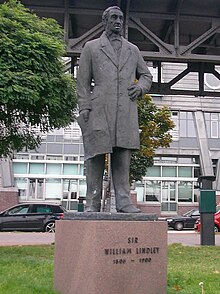William Lindley
| William Lindley | |
|---|---|

Statue of William Lindley in Hamburg-Neustadt, 2008
|
|
| Born |
7 September 1808 London |
| Died | 22 May 1900 (aged 91) Blackheath, London |
| Nationality | British |
| Known for | London sanitary sewer |
William Lindley (7 September 1808 in London – 22 May 1900 in Blackheath, London), was an English engineer who together with his sons designed water and sewerage systems for over 30 cities across Europe.
As a young engineer he worked together with Marc Isambard Brunel and Francis Giles. In 1834 he went to Germany as Giles' assistant to survey the railway route from Lübeck to Hamburg. A few years later, in 1838, he was commissioned to build the Hamburg-Bergedorf Railway Company (German: Hamburg-Bergedorfer Eisenbahn), the first railway line which was carried out in northern Germany. The official opening had to be cancelled as a catastrophic fire in May 1842 left a third of the town in ruins. Lindley became a member of the Technical Commission for the reconstruction of the town centre (with Alexis de Chateauneuf, Gottfried Semper and others) and designed the first fundamental plan for the reconstruction of the city. For the engineer, who had already been commissioned to design a new sewer system for Hamburg, the destruction was an opportunity to modernise the city.
His designs, influenced by English social reformer and public health inspector Edwin Chadwick, included the first underground sewers in continental Europe. Within three years 11 km of sewers had been built in Hamburg, and Lindley began work on a waterworks to supply the city with drinking water. In the following years he helped design and build water systems in a number of other German cities and towns such as Altona, Stralsund and Leipzig.
At Hamburg Lindley developed an increasing interest in urban planning. In 1840 he was commissioned to drain the Hammerbrook marshes, east of the town centre of Hamburg. This drainage system, which was implemented by the construction of a grid of canals connected by locks with the Elbe river (1842–47), provided the basis of the first modern suburb at Hamburg, primarily as an industrial area. In 1855 he also designed an early master plan for the development of the areas west of the town centre. But as his design for the Hamburg harbour (1845, with James Walker and Heinrich Hübbe) was used, the plan was not carried out.
...
Wikipedia
